Economics for Business: Analyzing Scarcity and Cost in the UK
VerifiedAdded on 2023/06/13
|10
|3185
|311
Report
AI Summary
This report analyzes the impact of resource scarcity and opportunity cost on microeconomic decision-making for households and individuals in the UK. It explores how scarcity of resources, such as time, money, and natural resources, affects individual choices and the need to sacrifice alternatives. The concept of opportunity cost, where individuals forego the next best alternative, is discussed in relation to explicit and implicit costs. The report further examines how cost-benefit analysis and incentives influence microeconomic decisions, emphasizing the importance of evaluating rewards and costs associated with different options. It also touches upon challenges related to resource allocation, consumption patterns, and the need for strategies to cope with scarcity in the UK economy. Desklib offers a platform for students to access similar solved assignments and past papers.
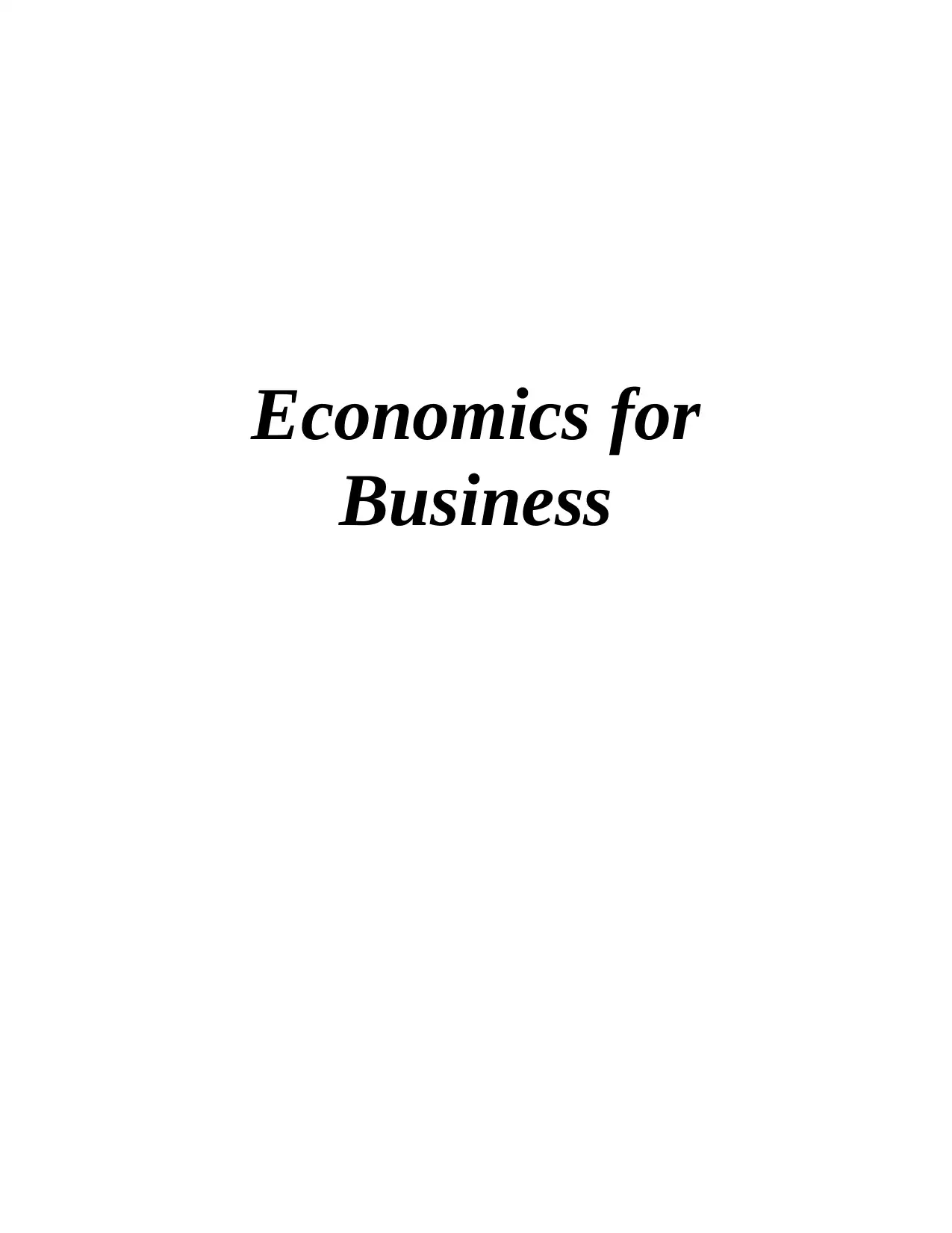
Economics for
Business
Business
Paraphrase This Document
Need a fresh take? Get an instant paraphrase of this document with our AI Paraphraser
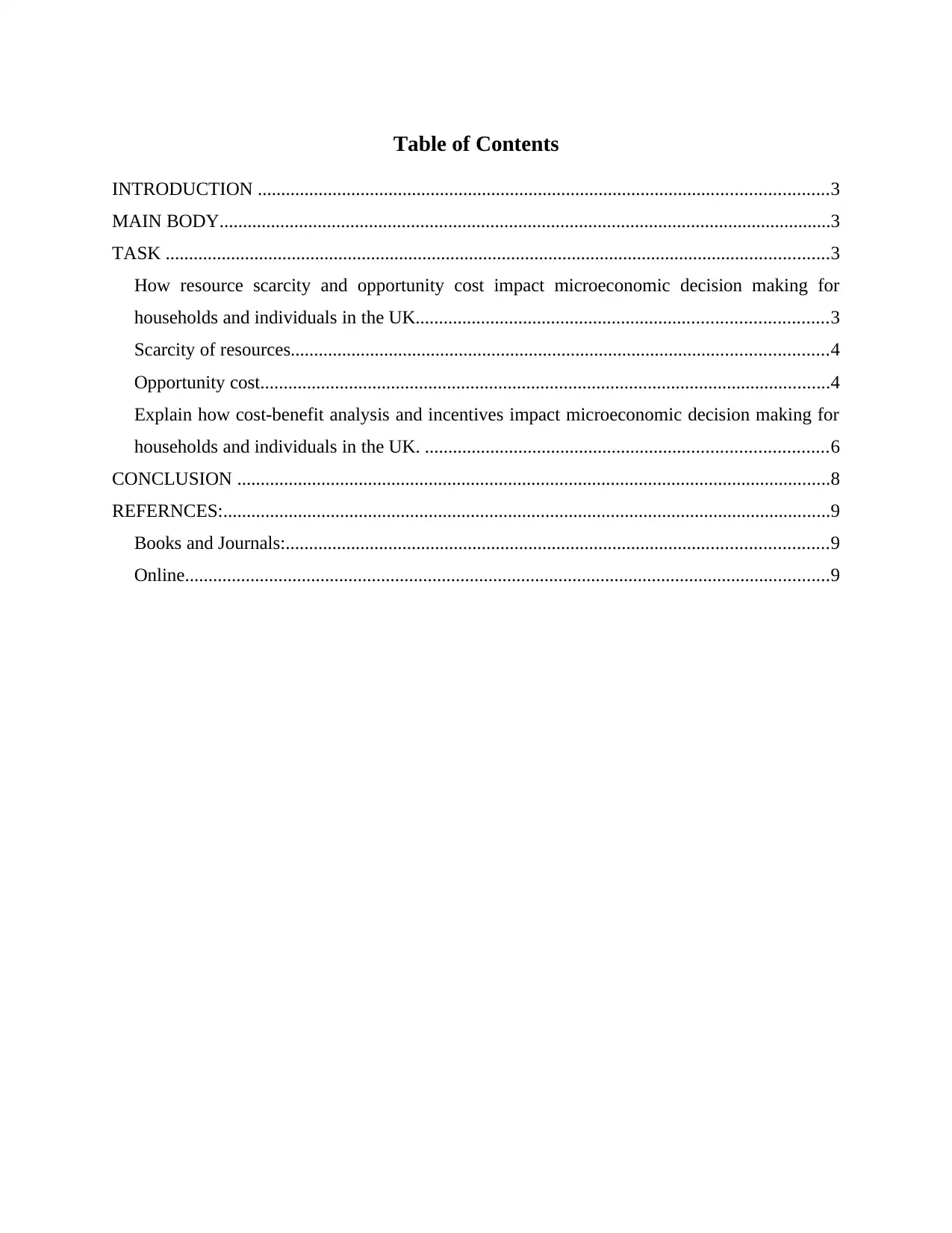
Table of Contents
INTRODUCTION ..........................................................................................................................3
MAIN BODY...................................................................................................................................3
TASK ..............................................................................................................................................3
How resource scarcity and opportunity cost impact microeconomic decision making for
households and individuals in the UK........................................................................................3
Scarcity of resources...................................................................................................................4
Opportunity cost..........................................................................................................................4
Explain how cost-benefit analysis and incentives impact microeconomic decision making for
households and individuals in the UK. ......................................................................................6
CONCLUSION ...............................................................................................................................8
REFERNCES:..................................................................................................................................9
Books and Journals:....................................................................................................................9
Online..........................................................................................................................................9
INTRODUCTION ..........................................................................................................................3
MAIN BODY...................................................................................................................................3
TASK ..............................................................................................................................................3
How resource scarcity and opportunity cost impact microeconomic decision making for
households and individuals in the UK........................................................................................3
Scarcity of resources...................................................................................................................4
Opportunity cost..........................................................................................................................4
Explain how cost-benefit analysis and incentives impact microeconomic decision making for
households and individuals in the UK. ......................................................................................6
CONCLUSION ...............................................................................................................................8
REFERNCES:..................................................................................................................................9
Books and Journals:....................................................................................................................9
Online..........................................................................................................................................9
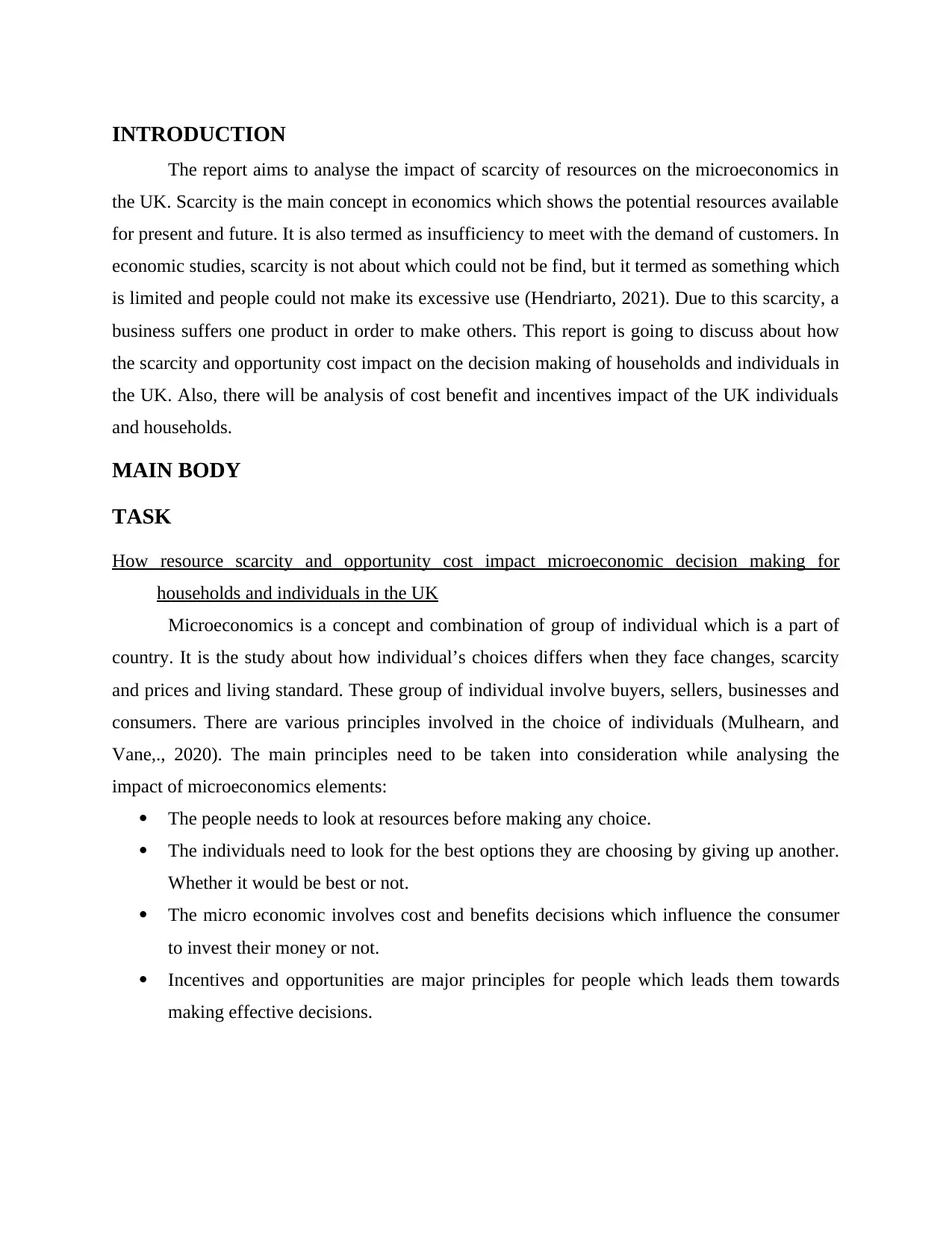
INTRODUCTION
The report aims to analyse the impact of scarcity of resources on the microeconomics in
the UK. Scarcity is the main concept in economics which shows the potential resources available
for present and future. It is also termed as insufficiency to meet with the demand of customers. In
economic studies, scarcity is not about which could not be find, but it termed as something which
is limited and people could not make its excessive use (Hendriarto, 2021). Due to this scarcity, a
business suffers one product in order to make others. This report is going to discuss about how
the scarcity and opportunity cost impact on the decision making of households and individuals in
the UK. Also, there will be analysis of cost benefit and incentives impact of the UK individuals
and households.
MAIN BODY
TASK
How resource scarcity and opportunity cost impact microeconomic decision making for
households and individuals in the UK
Microeconomics is a concept and combination of group of individual which is a part of
country. It is the study about how individual’s choices differs when they face changes, scarcity
and prices and living standard. These group of individual involve buyers, sellers, businesses and
consumers. There are various principles involved in the choice of individuals (Mulhearn, and
Vane,., 2020). The main principles need to be taken into consideration while analysing the
impact of microeconomics elements:
The people needs to look at resources before making any choice.
The individuals need to look for the best options they are choosing by giving up another.
Whether it would be best or not.
The micro economic involves cost and benefits decisions which influence the consumer
to invest their money or not.
Incentives and opportunities are major principles for people which leads them towards
making effective decisions.
The report aims to analyse the impact of scarcity of resources on the microeconomics in
the UK. Scarcity is the main concept in economics which shows the potential resources available
for present and future. It is also termed as insufficiency to meet with the demand of customers. In
economic studies, scarcity is not about which could not be find, but it termed as something which
is limited and people could not make its excessive use (Hendriarto, 2021). Due to this scarcity, a
business suffers one product in order to make others. This report is going to discuss about how
the scarcity and opportunity cost impact on the decision making of households and individuals in
the UK. Also, there will be analysis of cost benefit and incentives impact of the UK individuals
and households.
MAIN BODY
TASK
How resource scarcity and opportunity cost impact microeconomic decision making for
households and individuals in the UK
Microeconomics is a concept and combination of group of individual which is a part of
country. It is the study about how individual’s choices differs when they face changes, scarcity
and prices and living standard. These group of individual involve buyers, sellers, businesses and
consumers. There are various principles involved in the choice of individuals (Mulhearn, and
Vane,., 2020). The main principles need to be taken into consideration while analysing the
impact of microeconomics elements:
The people needs to look at resources before making any choice.
The individuals need to look for the best options they are choosing by giving up another.
Whether it would be best or not.
The micro economic involves cost and benefits decisions which influence the consumer
to invest their money or not.
Incentives and opportunities are major principles for people which leads them towards
making effective decisions.
⊘ This is a preview!⊘
Do you want full access?
Subscribe today to unlock all pages.

Trusted by 1+ million students worldwide
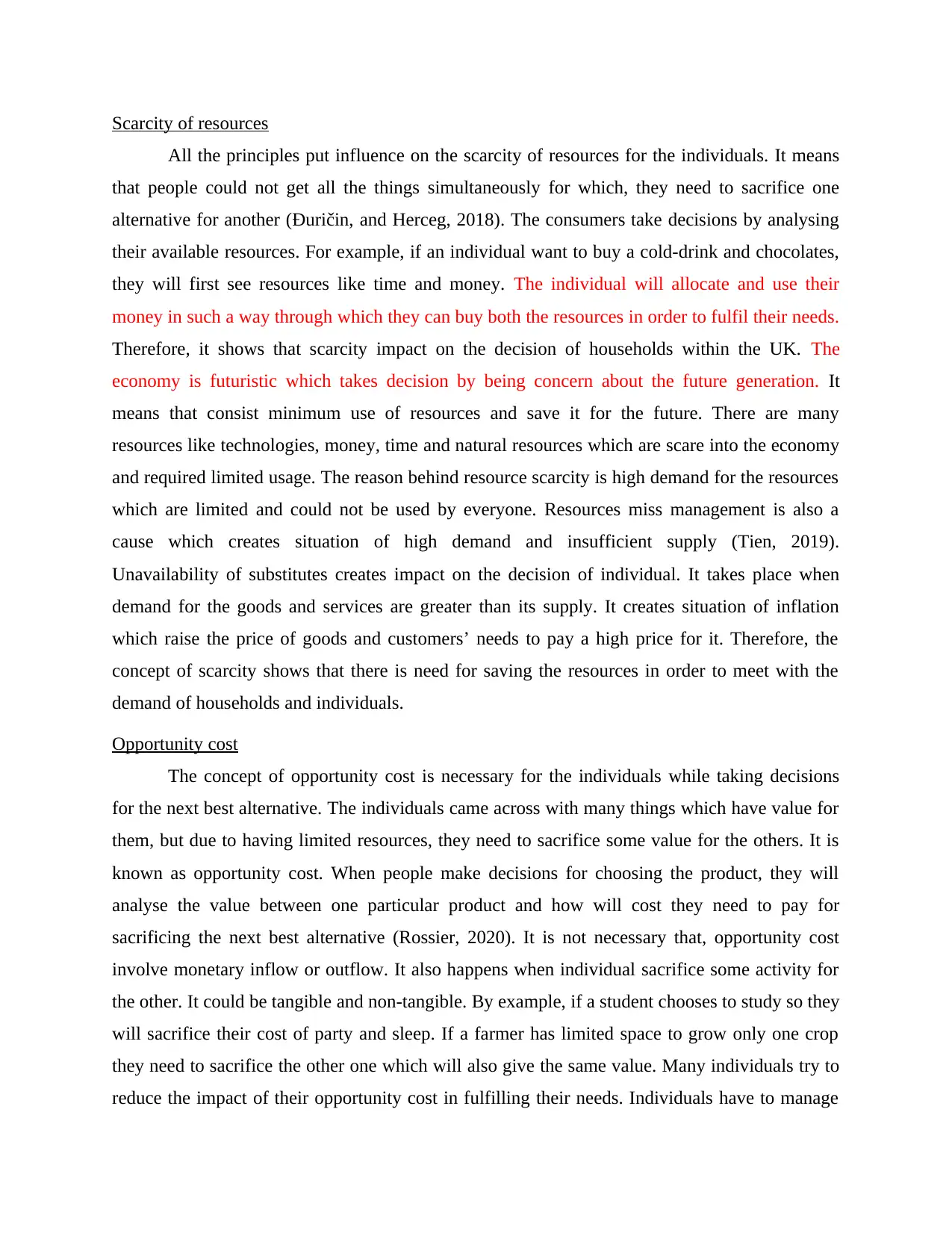
Scarcity of resources
All the principles put influence on the scarcity of resources for the individuals. It means
that people could not get all the things simultaneously for which, they need to sacrifice one
alternative for another (Đuričin, and Herceg, 2018). The consumers take decisions by analysing
their available resources. For example, if an individual want to buy a cold-drink and chocolates,
they will first see resources like time and money. The individual will allocate and use their
money in such a way through which they can buy both the resources in order to fulfil their needs.
Therefore, it shows that scarcity impact on the decision of households within the UK. The
economy is futuristic which takes decision by being concern about the future generation. It
means that consist minimum use of resources and save it for the future. There are many
resources like technologies, money, time and natural resources which are scare into the economy
and required limited usage. The reason behind resource scarcity is high demand for the resources
which are limited and could not be used by everyone. Resources miss management is also a
cause which creates situation of high demand and insufficient supply (Tien, 2019).
Unavailability of substitutes creates impact on the decision of individual. It takes place when
demand for the goods and services are greater than its supply. It creates situation of inflation
which raise the price of goods and customers’ needs to pay a high price for it. Therefore, the
concept of scarcity shows that there is need for saving the resources in order to meet with the
demand of households and individuals.
Opportunity cost
The concept of opportunity cost is necessary for the individuals while taking decisions
for the next best alternative. The individuals came across with many things which have value for
them, but due to having limited resources, they need to sacrifice some value for the others. It is
known as opportunity cost. When people make decisions for choosing the product, they will
analyse the value between one particular product and how will cost they need to pay for
sacrificing the next best alternative (Rossier, 2020). It is not necessary that, opportunity cost
involve monetary inflow or outflow. It also happens when individual sacrifice some activity for
the other. It could be tangible and non-tangible. By example, if a student chooses to study so they
will sacrifice their cost of party and sleep. If a farmer has limited space to grow only one crop
they need to sacrifice the other one which will also give the same value. Many individuals try to
reduce the impact of their opportunity cost in fulfilling their needs. Individuals have to manage
All the principles put influence on the scarcity of resources for the individuals. It means
that people could not get all the things simultaneously for which, they need to sacrifice one
alternative for another (Đuričin, and Herceg, 2018). The consumers take decisions by analysing
their available resources. For example, if an individual want to buy a cold-drink and chocolates,
they will first see resources like time and money. The individual will allocate and use their
money in such a way through which they can buy both the resources in order to fulfil their needs.
Therefore, it shows that scarcity impact on the decision of households within the UK. The
economy is futuristic which takes decision by being concern about the future generation. It
means that consist minimum use of resources and save it for the future. There are many
resources like technologies, money, time and natural resources which are scare into the economy
and required limited usage. The reason behind resource scarcity is high demand for the resources
which are limited and could not be used by everyone. Resources miss management is also a
cause which creates situation of high demand and insufficient supply (Tien, 2019).
Unavailability of substitutes creates impact on the decision of individual. It takes place when
demand for the goods and services are greater than its supply. It creates situation of inflation
which raise the price of goods and customers’ needs to pay a high price for it. Therefore, the
concept of scarcity shows that there is need for saving the resources in order to meet with the
demand of households and individuals.
Opportunity cost
The concept of opportunity cost is necessary for the individuals while taking decisions
for the next best alternative. The individuals came across with many things which have value for
them, but due to having limited resources, they need to sacrifice some value for the others. It is
known as opportunity cost. When people make decisions for choosing the product, they will
analyse the value between one particular product and how will cost they need to pay for
sacrificing the next best alternative (Rossier, 2020). It is not necessary that, opportunity cost
involve monetary inflow or outflow. It also happens when individual sacrifice some activity for
the other. It could be tangible and non-tangible. By example, if a student chooses to study so they
will sacrifice their cost of party and sleep. If a farmer has limited space to grow only one crop
they need to sacrifice the other one which will also give the same value. Many individuals try to
reduce the impact of their opportunity cost in fulfilling their needs. Individuals have to manage
Paraphrase This Document
Need a fresh take? Get an instant paraphrase of this document with our AI Paraphraser
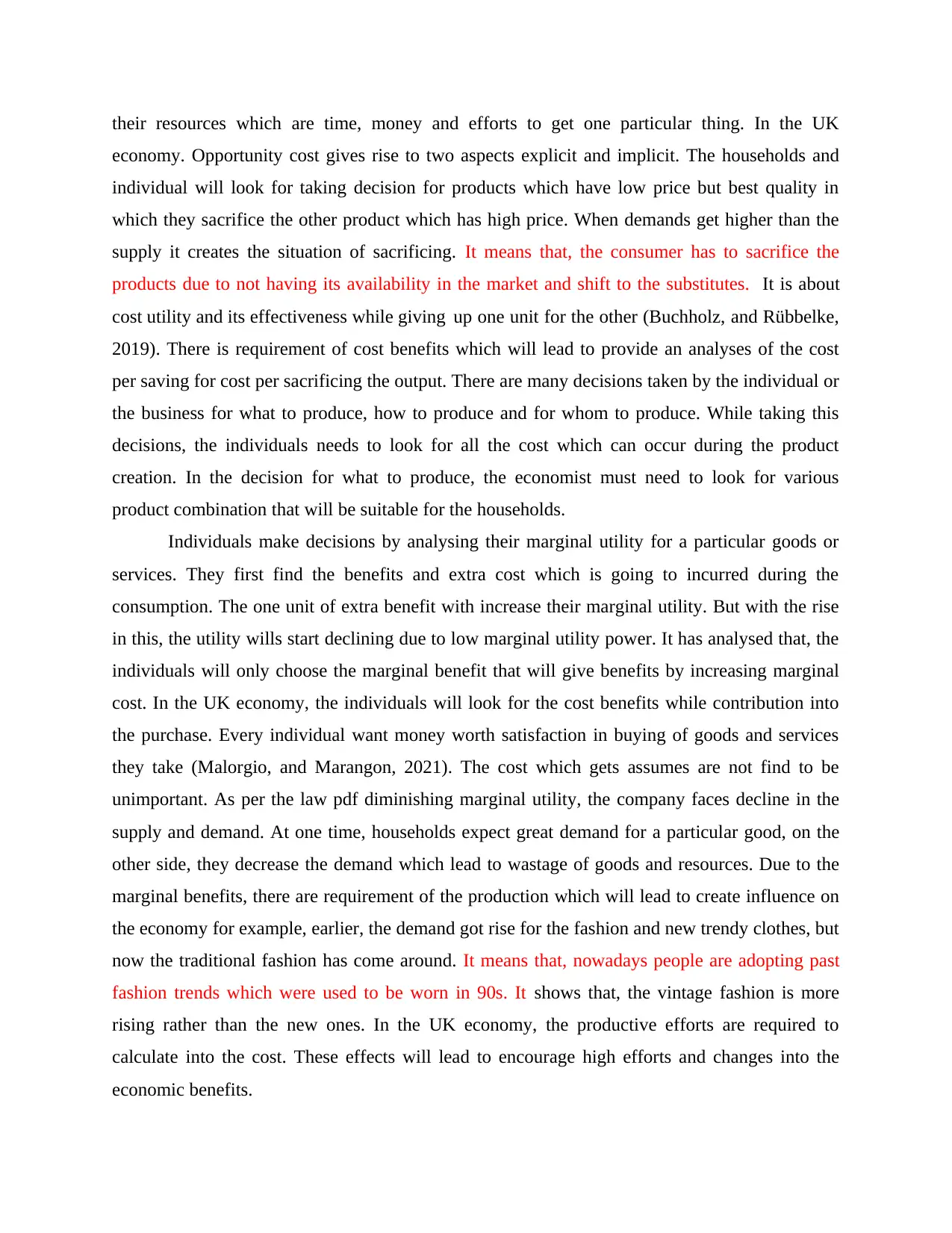
their resources which are time, money and efforts to get one particular thing. In the UK
economy. Opportunity cost gives rise to two aspects explicit and implicit. The households and
individual will look for taking decision for products which have low price but best quality in
which they sacrifice the other product which has high price. When demands get higher than the
supply it creates the situation of sacrificing. It means that, the consumer has to sacrifice the
products due to not having its availability in the market and shift to the substitutes. It is about
cost utility and its effectiveness while giving up one unit for the other (Buchholz, and Rübbelke,
2019). There is requirement of cost benefits which will lead to provide an analyses of the cost
per saving for cost per sacrificing the output. There are many decisions taken by the individual or
the business for what to produce, how to produce and for whom to produce. While taking this
decisions, the individuals needs to look for all the cost which can occur during the product
creation. In the decision for what to produce, the economist must need to look for various
product combination that will be suitable for the households.
Individuals make decisions by analysing their marginal utility for a particular goods or
services. They first find the benefits and extra cost which is going to incurred during the
consumption. The one unit of extra benefit with increase their marginal utility. But with the rise
in this, the utility wills start declining due to low marginal utility power. It has analysed that, the
individuals will only choose the marginal benefit that will give benefits by increasing marginal
cost. In the UK economy, the individuals will look for the cost benefits while contribution into
the purchase. Every individual want money worth satisfaction in buying of goods and services
they take (Malorgio, and Marangon, 2021). The cost which gets assumes are not find to be
unimportant. As per the law pdf diminishing marginal utility, the company faces decline in the
supply and demand. At one time, households expect great demand for a particular good, on the
other side, they decrease the demand which lead to wastage of goods and resources. Due to the
marginal benefits, there are requirement of the production which will lead to create influence on
the economy for example, earlier, the demand got rise for the fashion and new trendy clothes, but
now the traditional fashion has come around. It means that, nowadays people are adopting past
fashion trends which were used to be worn in 90s. It shows that, the vintage fashion is more
rising rather than the new ones. In the UK economy, the productive efforts are required to
calculate into the cost. These effects will lead to encourage high efforts and changes into the
economic benefits.
economy. Opportunity cost gives rise to two aspects explicit and implicit. The households and
individual will look for taking decision for products which have low price but best quality in
which they sacrifice the other product which has high price. When demands get higher than the
supply it creates the situation of sacrificing. It means that, the consumer has to sacrifice the
products due to not having its availability in the market and shift to the substitutes. It is about
cost utility and its effectiveness while giving up one unit for the other (Buchholz, and Rübbelke,
2019). There is requirement of cost benefits which will lead to provide an analyses of the cost
per saving for cost per sacrificing the output. There are many decisions taken by the individual or
the business for what to produce, how to produce and for whom to produce. While taking this
decisions, the individuals needs to look for all the cost which can occur during the product
creation. In the decision for what to produce, the economist must need to look for various
product combination that will be suitable for the households.
Individuals make decisions by analysing their marginal utility for a particular goods or
services. They first find the benefits and extra cost which is going to incurred during the
consumption. The one unit of extra benefit with increase their marginal utility. But with the rise
in this, the utility wills start declining due to low marginal utility power. It has analysed that, the
individuals will only choose the marginal benefit that will give benefits by increasing marginal
cost. In the UK economy, the individuals will look for the cost benefits while contribution into
the purchase. Every individual want money worth satisfaction in buying of goods and services
they take (Malorgio, and Marangon, 2021). The cost which gets assumes are not find to be
unimportant. As per the law pdf diminishing marginal utility, the company faces decline in the
supply and demand. At one time, households expect great demand for a particular good, on the
other side, they decrease the demand which lead to wastage of goods and resources. Due to the
marginal benefits, there are requirement of the production which will lead to create influence on
the economy for example, earlier, the demand got rise for the fashion and new trendy clothes, but
now the traditional fashion has come around. It means that, nowadays people are adopting past
fashion trends which were used to be worn in 90s. It shows that, the vintage fashion is more
rising rather than the new ones. In the UK economy, the productive efforts are required to
calculate into the cost. These effects will lead to encourage high efforts and changes into the
economic benefits.
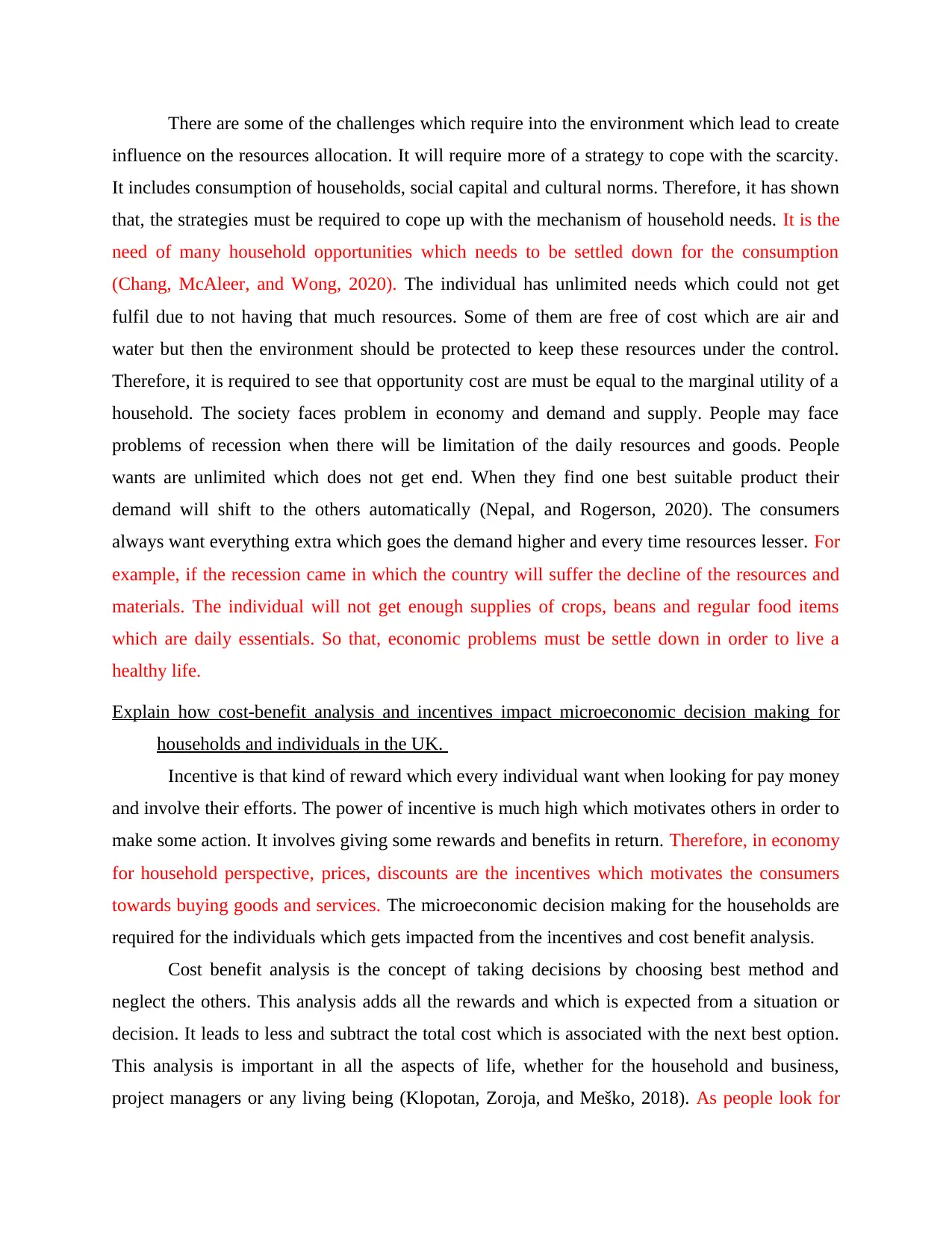
There are some of the challenges which require into the environment which lead to create
influence on the resources allocation. It will require more of a strategy to cope with the scarcity.
It includes consumption of households, social capital and cultural norms. Therefore, it has shown
that, the strategies must be required to cope up with the mechanism of household needs. It is the
need of many household opportunities which needs to be settled down for the consumption
(Chang, McAleer, and Wong, 2020). The individual has unlimited needs which could not get
fulfil due to not having that much resources. Some of them are free of cost which are air and
water but then the environment should be protected to keep these resources under the control.
Therefore, it is required to see that opportunity cost are must be equal to the marginal utility of a
household. The society faces problem in economy and demand and supply. People may face
problems of recession when there will be limitation of the daily resources and goods. People
wants are unlimited which does not get end. When they find one best suitable product their
demand will shift to the others automatically (Nepal, and Rogerson, 2020). The consumers
always want everything extra which goes the demand higher and every time resources lesser. For
example, if the recession came in which the country will suffer the decline of the resources and
materials. The individual will not get enough supplies of crops, beans and regular food items
which are daily essentials. So that, economic problems must be settle down in order to live a
healthy life.
Explain how cost-benefit analysis and incentives impact microeconomic decision making for
households and individuals in the UK.
Incentive is that kind of reward which every individual want when looking for pay money
and involve their efforts. The power of incentive is much high which motivates others in order to
make some action. It involves giving some rewards and benefits in return. Therefore, in economy
for household perspective, prices, discounts are the incentives which motivates the consumers
towards buying goods and services. The microeconomic decision making for the households are
required for the individuals which gets impacted from the incentives and cost benefit analysis.
Cost benefit analysis is the concept of taking decisions by choosing best method and
neglect the others. This analysis adds all the rewards and which is expected from a situation or
decision. It leads to less and subtract the total cost which is associated with the next best option.
This analysis is important in all the aspects of life, whether for the household and business,
project managers or any living being (Klopotan, Zoroja, and Meško, 2018). As people look for
influence on the resources allocation. It will require more of a strategy to cope with the scarcity.
It includes consumption of households, social capital and cultural norms. Therefore, it has shown
that, the strategies must be required to cope up with the mechanism of household needs. It is the
need of many household opportunities which needs to be settled down for the consumption
(Chang, McAleer, and Wong, 2020). The individual has unlimited needs which could not get
fulfil due to not having that much resources. Some of them are free of cost which are air and
water but then the environment should be protected to keep these resources under the control.
Therefore, it is required to see that opportunity cost are must be equal to the marginal utility of a
household. The society faces problem in economy and demand and supply. People may face
problems of recession when there will be limitation of the daily resources and goods. People
wants are unlimited which does not get end. When they find one best suitable product their
demand will shift to the others automatically (Nepal, and Rogerson, 2020). The consumers
always want everything extra which goes the demand higher and every time resources lesser. For
example, if the recession came in which the country will suffer the decline of the resources and
materials. The individual will not get enough supplies of crops, beans and regular food items
which are daily essentials. So that, economic problems must be settle down in order to live a
healthy life.
Explain how cost-benefit analysis and incentives impact microeconomic decision making for
households and individuals in the UK.
Incentive is that kind of reward which every individual want when looking for pay money
and involve their efforts. The power of incentive is much high which motivates others in order to
make some action. It involves giving some rewards and benefits in return. Therefore, in economy
for household perspective, prices, discounts are the incentives which motivates the consumers
towards buying goods and services. The microeconomic decision making for the households are
required for the individuals which gets impacted from the incentives and cost benefit analysis.
Cost benefit analysis is the concept of taking decisions by choosing best method and
neglect the others. This analysis adds all the rewards and which is expected from a situation or
decision. It leads to less and subtract the total cost which is associated with the next best option.
This analysis is important in all the aspects of life, whether for the household and business,
project managers or any living being (Klopotan, Zoroja, and Meško, 2018). As people look for
⊘ This is a preview!⊘
Do you want full access?
Subscribe today to unlock all pages.

Trusted by 1+ million students worldwide
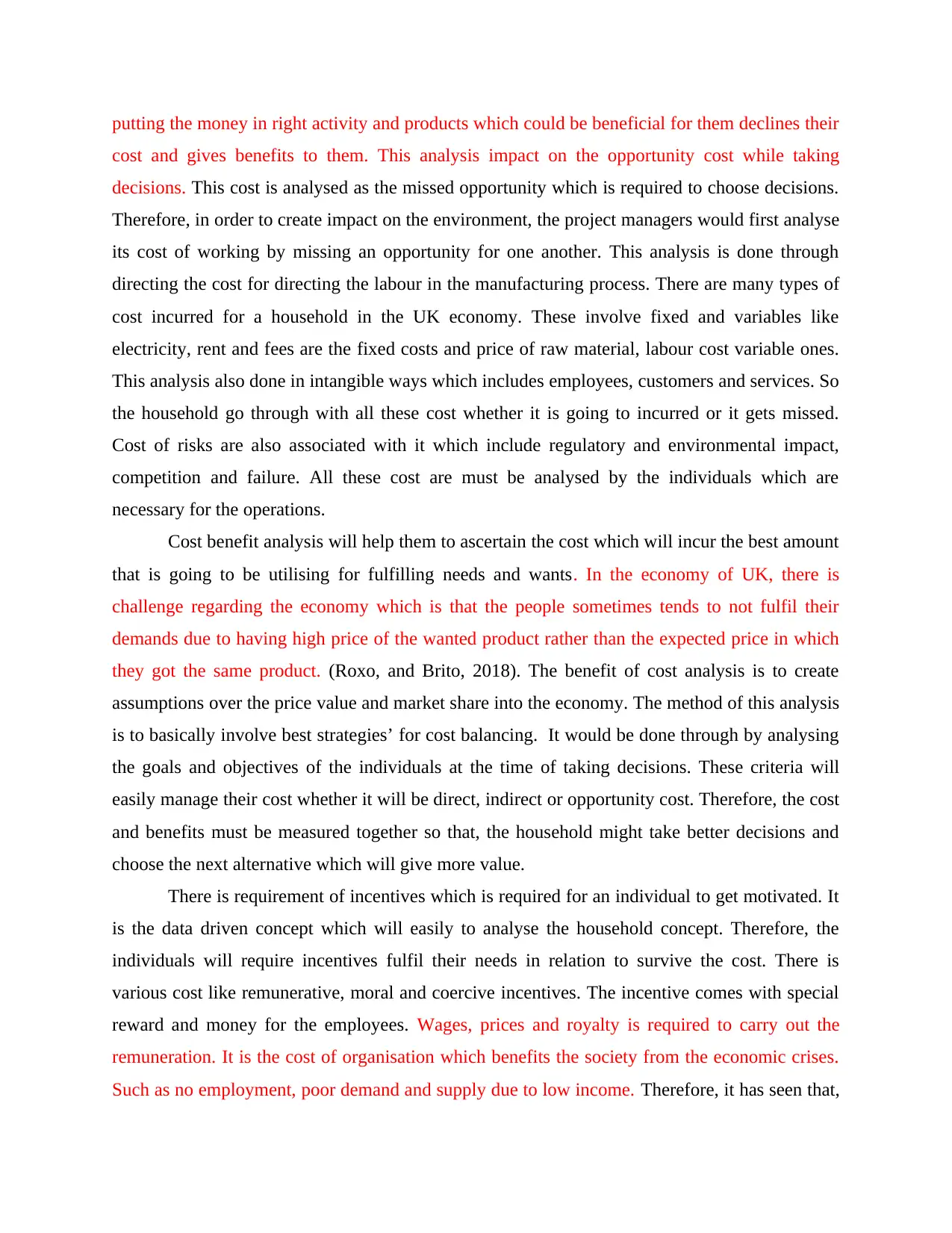
putting the money in right activity and products which could be beneficial for them declines their
cost and gives benefits to them. This analysis impact on the opportunity cost while taking
decisions. This cost is analysed as the missed opportunity which is required to choose decisions.
Therefore, in order to create impact on the environment, the project managers would first analyse
its cost of working by missing an opportunity for one another. This analysis is done through
directing the cost for directing the labour in the manufacturing process. There are many types of
cost incurred for a household in the UK economy. These involve fixed and variables like
electricity, rent and fees are the fixed costs and price of raw material, labour cost variable ones.
This analysis also done in intangible ways which includes employees, customers and services. So
the household go through with all these cost whether it is going to incurred or it gets missed.
Cost of risks are also associated with it which include regulatory and environmental impact,
competition and failure. All these cost are must be analysed by the individuals which are
necessary for the operations.
Cost benefit analysis will help them to ascertain the cost which will incur the best amount
that is going to be utilising for fulfilling needs and wants. In the economy of UK, there is
challenge regarding the economy which is that the people sometimes tends to not fulfil their
demands due to having high price of the wanted product rather than the expected price in which
they got the same product. (Roxo, and Brito, 2018). The benefit of cost analysis is to create
assumptions over the price value and market share into the economy. The method of this analysis
is to basically involve best strategies’ for cost balancing. It would be done through by analysing
the goals and objectives of the individuals at the time of taking decisions. These criteria will
easily manage their cost whether it will be direct, indirect or opportunity cost. Therefore, the cost
and benefits must be measured together so that, the household might take better decisions and
choose the next alternative which will give more value.
There is requirement of incentives which is required for an individual to get motivated. It
is the data driven concept which will easily to analyse the household concept. Therefore, the
individuals will require incentives fulfil their needs in relation to survive the cost. There is
various cost like remunerative, moral and coercive incentives. The incentive comes with special
reward and money for the employees. Wages, prices and royalty is required to carry out the
remuneration. It is the cost of organisation which benefits the society from the economic crises.
Such as no employment, poor demand and supply due to low income. Therefore, it has seen that,
cost and gives benefits to them. This analysis impact on the opportunity cost while taking
decisions. This cost is analysed as the missed opportunity which is required to choose decisions.
Therefore, in order to create impact on the environment, the project managers would first analyse
its cost of working by missing an opportunity for one another. This analysis is done through
directing the cost for directing the labour in the manufacturing process. There are many types of
cost incurred for a household in the UK economy. These involve fixed and variables like
electricity, rent and fees are the fixed costs and price of raw material, labour cost variable ones.
This analysis also done in intangible ways which includes employees, customers and services. So
the household go through with all these cost whether it is going to incurred or it gets missed.
Cost of risks are also associated with it which include regulatory and environmental impact,
competition and failure. All these cost are must be analysed by the individuals which are
necessary for the operations.
Cost benefit analysis will help them to ascertain the cost which will incur the best amount
that is going to be utilising for fulfilling needs and wants. In the economy of UK, there is
challenge regarding the economy which is that the people sometimes tends to not fulfil their
demands due to having high price of the wanted product rather than the expected price in which
they got the same product. (Roxo, and Brito, 2018). The benefit of cost analysis is to create
assumptions over the price value and market share into the economy. The method of this analysis
is to basically involve best strategies’ for cost balancing. It would be done through by analysing
the goals and objectives of the individuals at the time of taking decisions. These criteria will
easily manage their cost whether it will be direct, indirect or opportunity cost. Therefore, the cost
and benefits must be measured together so that, the household might take better decisions and
choose the next alternative which will give more value.
There is requirement of incentives which is required for an individual to get motivated. It
is the data driven concept which will easily to analyse the household concept. Therefore, the
individuals will require incentives fulfil their needs in relation to survive the cost. There is
various cost like remunerative, moral and coercive incentives. The incentive comes with special
reward and money for the employees. Wages, prices and royalty is required to carry out the
remuneration. It is the cost of organisation which benefits the society from the economic crises.
Such as no employment, poor demand and supply due to low income. Therefore, it has seen that,
Paraphrase This Document
Need a fresh take? Get an instant paraphrase of this document with our AI Paraphraser
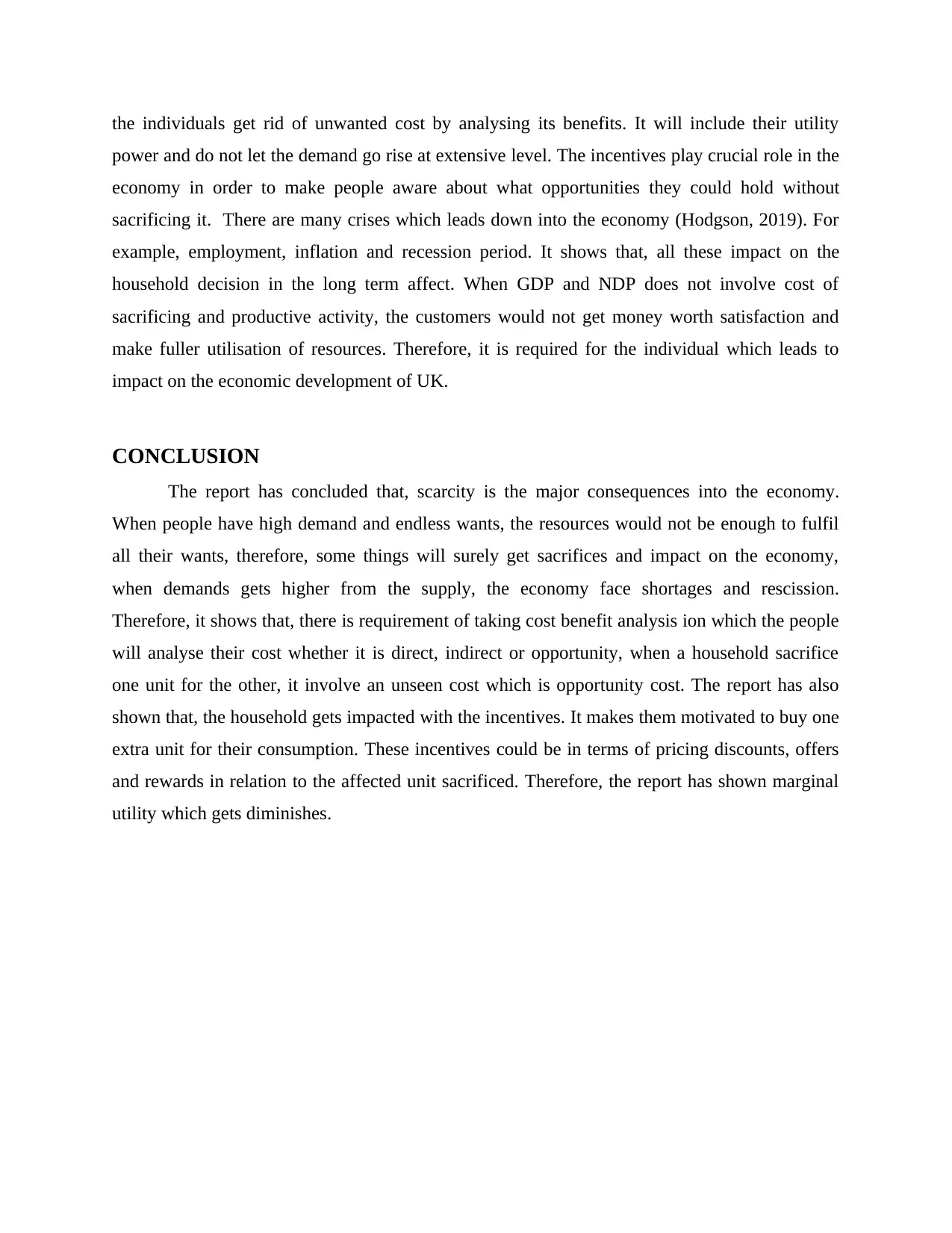
the individuals get rid of unwanted cost by analysing its benefits. It will include their utility
power and do not let the demand go rise at extensive level. The incentives play crucial role in the
economy in order to make people aware about what opportunities they could hold without
sacrificing it. There are many crises which leads down into the economy (Hodgson, 2019). For
example, employment, inflation and recession period. It shows that, all these impact on the
household decision in the long term affect. When GDP and NDP does not involve cost of
sacrificing and productive activity, the customers would not get money worth satisfaction and
make fuller utilisation of resources. Therefore, it is required for the individual which leads to
impact on the economic development of UK.
CONCLUSION
The report has concluded that, scarcity is the major consequences into the economy.
When people have high demand and endless wants, the resources would not be enough to fulfil
all their wants, therefore, some things will surely get sacrifices and impact on the economy,
when demands gets higher from the supply, the economy face shortages and rescission.
Therefore, it shows that, there is requirement of taking cost benefit analysis ion which the people
will analyse their cost whether it is direct, indirect or opportunity, when a household sacrifice
one unit for the other, it involve an unseen cost which is opportunity cost. The report has also
shown that, the household gets impacted with the incentives. It makes them motivated to buy one
extra unit for their consumption. These incentives could be in terms of pricing discounts, offers
and rewards in relation to the affected unit sacrificed. Therefore, the report has shown marginal
utility which gets diminishes.
power and do not let the demand go rise at extensive level. The incentives play crucial role in the
economy in order to make people aware about what opportunities they could hold without
sacrificing it. There are many crises which leads down into the economy (Hodgson, 2019). For
example, employment, inflation and recession period. It shows that, all these impact on the
household decision in the long term affect. When GDP and NDP does not involve cost of
sacrificing and productive activity, the customers would not get money worth satisfaction and
make fuller utilisation of resources. Therefore, it is required for the individual which leads to
impact on the economic development of UK.
CONCLUSION
The report has concluded that, scarcity is the major consequences into the economy.
When people have high demand and endless wants, the resources would not be enough to fulfil
all their wants, therefore, some things will surely get sacrifices and impact on the economy,
when demands gets higher from the supply, the economy face shortages and rescission.
Therefore, it shows that, there is requirement of taking cost benefit analysis ion which the people
will analyse their cost whether it is direct, indirect or opportunity, when a household sacrifice
one unit for the other, it involve an unseen cost which is opportunity cost. The report has also
shown that, the household gets impacted with the incentives. It makes them motivated to buy one
extra unit for their consumption. These incentives could be in terms of pricing discounts, offers
and rewards in relation to the affected unit sacrificed. Therefore, the report has shown marginal
utility which gets diminishes.
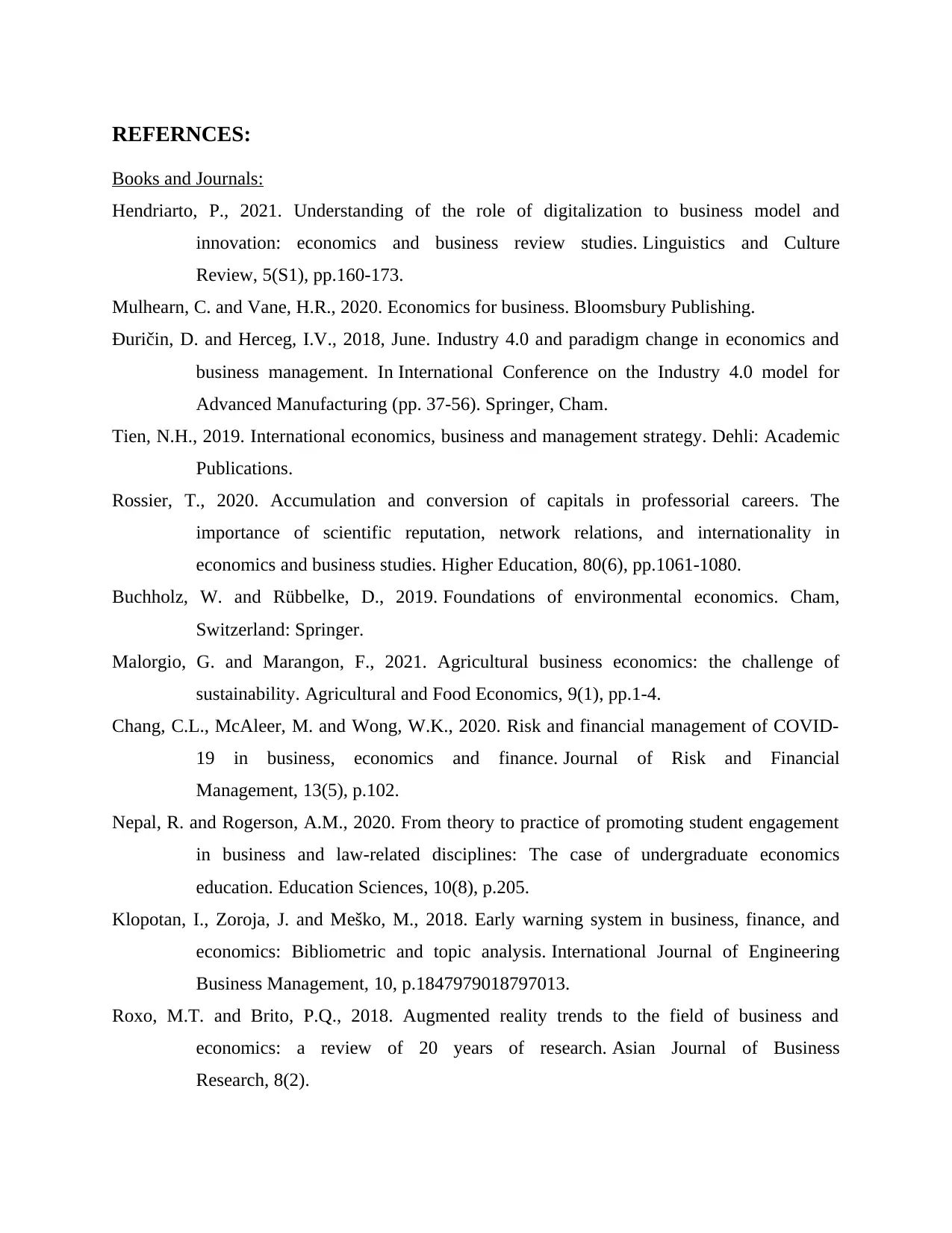
REFERNCES:
Books and Journals:
Hendriarto, P., 2021. Understanding of the role of digitalization to business model and
innovation: economics and business review studies. Linguistics and Culture
Review, 5(S1), pp.160-173.
Mulhearn, C. and Vane, H.R., 2020. Economics for business. Bloomsbury Publishing.
Đuričin, D. and Herceg, I.V., 2018, June. Industry 4.0 and paradigm change in economics and
business management. In International Conference on the Industry 4.0 model for
Advanced Manufacturing (pp. 37-56). Springer, Cham.
Tien, N.H., 2019. International economics, business and management strategy. Dehli: Academic
Publications.
Rossier, T., 2020. Accumulation and conversion of capitals in professorial careers. The
importance of scientific reputation, network relations, and internationality in
economics and business studies. Higher Education, 80(6), pp.1061-1080.
Buchholz, W. and Rübbelke, D., 2019. Foundations of environmental economics. Cham,
Switzerland: Springer.
Malorgio, G. and Marangon, F., 2021. Agricultural business economics: the challenge of
sustainability. Agricultural and Food Economics, 9(1), pp.1-4.
Chang, C.L., McAleer, M. and Wong, W.K., 2020. Risk and financial management of COVID-
19 in business, economics and finance. Journal of Risk and Financial
Management, 13(5), p.102.
Nepal, R. and Rogerson, A.M., 2020. From theory to practice of promoting student engagement
in business and law-related disciplines: The case of undergraduate economics
education. Education Sciences, 10(8), p.205.
Klopotan, I., Zoroja, J. and Meško, M., 2018. Early warning system in business, finance, and
economics: Bibliometric and topic analysis. International Journal of Engineering
Business Management, 10, p.1847979018797013.
Roxo, M.T. and Brito, P.Q., 2018. Augmented reality trends to the field of business and
economics: a review of 20 years of research. Asian Journal of Business
Research, 8(2).
Books and Journals:
Hendriarto, P., 2021. Understanding of the role of digitalization to business model and
innovation: economics and business review studies. Linguistics and Culture
Review, 5(S1), pp.160-173.
Mulhearn, C. and Vane, H.R., 2020. Economics for business. Bloomsbury Publishing.
Đuričin, D. and Herceg, I.V., 2018, June. Industry 4.0 and paradigm change in economics and
business management. In International Conference on the Industry 4.0 model for
Advanced Manufacturing (pp. 37-56). Springer, Cham.
Tien, N.H., 2019. International economics, business and management strategy. Dehli: Academic
Publications.
Rossier, T., 2020. Accumulation and conversion of capitals in professorial careers. The
importance of scientific reputation, network relations, and internationality in
economics and business studies. Higher Education, 80(6), pp.1061-1080.
Buchholz, W. and Rübbelke, D., 2019. Foundations of environmental economics. Cham,
Switzerland: Springer.
Malorgio, G. and Marangon, F., 2021. Agricultural business economics: the challenge of
sustainability. Agricultural and Food Economics, 9(1), pp.1-4.
Chang, C.L., McAleer, M. and Wong, W.K., 2020. Risk and financial management of COVID-
19 in business, economics and finance. Journal of Risk and Financial
Management, 13(5), p.102.
Nepal, R. and Rogerson, A.M., 2020. From theory to practice of promoting student engagement
in business and law-related disciplines: The case of undergraduate economics
education. Education Sciences, 10(8), p.205.
Klopotan, I., Zoroja, J. and Meško, M., 2018. Early warning system in business, finance, and
economics: Bibliometric and topic analysis. International Journal of Engineering
Business Management, 10, p.1847979018797013.
Roxo, M.T. and Brito, P.Q., 2018. Augmented reality trends to the field of business and
economics: a review of 20 years of research. Asian Journal of Business
Research, 8(2).
⊘ This is a preview!⊘
Do you want full access?
Subscribe today to unlock all pages.

Trusted by 1+ million students worldwide
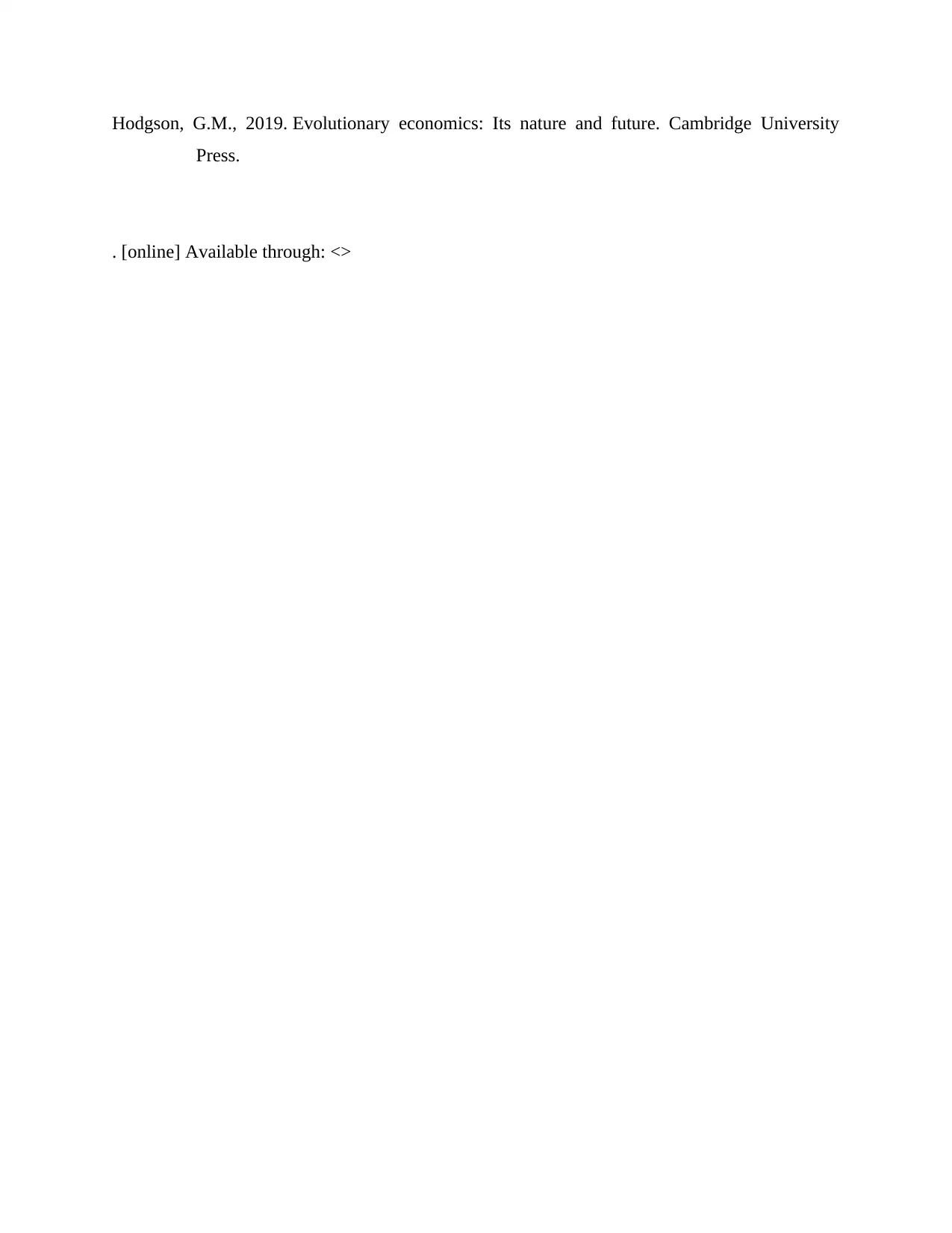
Hodgson, G.M., 2019. Evolutionary economics: Its nature and future. Cambridge University
Press.
. [online] Available through: <>
Press.
. [online] Available through: <>
1 out of 10
Related Documents
Your All-in-One AI-Powered Toolkit for Academic Success.
+13062052269
info@desklib.com
Available 24*7 on WhatsApp / Email
![[object Object]](/_next/static/media/star-bottom.7253800d.svg)
Unlock your academic potential
Copyright © 2020–2025 A2Z Services. All Rights Reserved. Developed and managed by ZUCOL.



